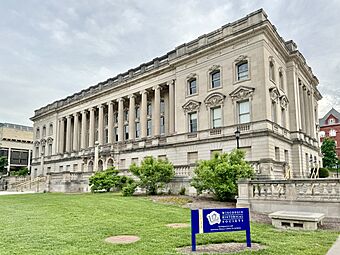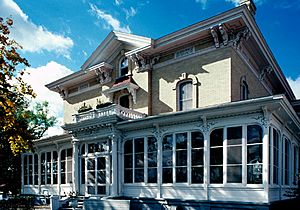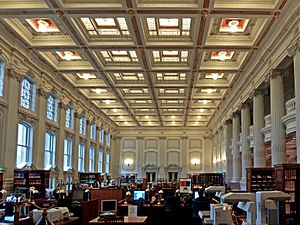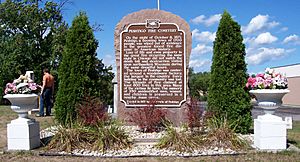Wisconsin Historical Society facts for kids
 |
|
| Agency overview | |
|---|---|
| Formed | 1846 |
| Jurisdiction | Wisconsin |
| Headquarters | 816 State Street Madison, Wisconsin 53706 |
| Agency executive |
|
| Parent agency | State of Wisconsin |
|
State Historical Society Library
|
|

The Society's headquarters and library
|
|
| Location | 816 State Street, Madison, Wisconsin |
|---|---|
| Built | 1896-1900 |
| Architect | Ferry & Clas |
| Architectural style | Neoclassical |
| NRHP reference No. | 72000049 |
| Added to NRHP | February 23, 1972 |
The Wisconsin Historical Society is a special group that works to save and share the history of North America. It focuses a lot on the history of Wisconsin and the areas west of the Appalachian Mountains. It started in 1846 and became official in 1853. This makes it the oldest historical society in the U.S. to always get money from the government. Its main office is in Madison, Wisconsin, right on the campus of the University of Wisconsin–Madison.
Contents
The Story of the Wisconsin Historical Society
How It All Started
Long ago, leaders in the Wisconsin Territory wanted to create a historical society. They learned that Massachusetts had lost some of its early history because its society started too late. So, in 1845, they began planning.
In 1846, during a meeting to write Wisconsin's state constitution, two more meetings were held. They created a plan for the society. A. Hyatt Smith became the first president, and Governor Doty was a vice-president. But for a few years, the new society didn't do much.
In January 1849, after Wisconsin became a state, people met again. They restarted the society. Governor Dewey was chosen as president. They wrote a new plan. Its goal was "to preserve the materials for a complete history of Wisconsin." This included old objects and stories of Native American tribes. The society started giving speeches and collecting books. But it still didn't have a paid helper, so progress was slow.
In 1853, the state government gave the society an official paper and $500. This money helped them achieve their goals. Members chose Lyman Draper as the main secretary. They adopted another new plan. It said the society's goal was to "collect, embody, arrange and preserve" many items. These included books, maps, and paintings about Wisconsin's history. They also wanted to save stories of early pioneers. The society aimed to show Wisconsin's past and present. It also wanted to encourage the study of history through talks and publications.
Unlike some other states, Wisconsin's founders wanted the society to be open to everyone. You just had to be interested and pay a small fee.
Making Early Progress
With these changes, and with Lyman Draper leading the way, the society began to grow. Draper asked for donations of books and old letters from early settlers. He also wanted descriptions of Native Americans and their ancient mounds. He collected newspapers and other papers.
In 1855, the society started publishing Wisconsin Historic Collections. This book came out every three years. It shared many stories about early Wisconsin that the society had collected. When the Civil War began, Draper asked Wisconsin army officers for war items. He also encouraged soldiers to write diaries.
In 1875, the society got the Perkins Collection. This was a huge collection of 9,000 Native American tools made of stone and copper. By 1876, the society had the largest library west of Washington D.C. It was visited by 20,000 to 35,000 people each year.
Reuben Gold Thwaites took over from Draper in 1887. He looked for missing items in the society's collection. He traveled around Wisconsin to find them. He also sent staff to other libraries to copy documents about Wisconsin. He made the society's library available to UW students. This was new for a library not part of a university.
He hired important assistants like Annie Nunns and Mary Stuart Foster. Their long time helping the society was even called "The Matriarchy." He also hired Louise Phelps Kellogg as a research assistant in 1901. Thwaites made the society's museum better. He wanted it to be interesting for everyone, not just those who liked the library.
Thwaites also encouraged local historical societies across the state. In 1898, he pushed for a state law to create a network of these local groups. The Wisconsin Historical Society would guide them. The first local societies joined in 1899 in Green Bay and Ripon. By this time, the WHS was seen as one of the best historical societies in the U.S.
The Historical Society's first home was just one bookcase in the state capitol in 1849. Later, its collection moved to Lyman Draper's basement, then his church's basement, and back to the capitol. These places were not very good and could easily catch fire. At the same time, the UW needed more space for its library.
In 1891, UW President Chamberlain suggested a new building. It would hold both the UW and Historical Society libraries. The state government gave money starting in 1895. Plans were asked for, and the design from Ferry & Clas of Milwaukee was chosen. The building was built from 1896 to 1900. It was finished just in time. Thwaites had called the old capitol a fire-trap, and much of it did burn in 1904.
The building designed by Ferry & Clas is considered a beautiful example of Neoclassical Revival style in Wisconsin. It has four stories. The front has a central row of columns across the second and third floors. It is made of Bedford sandstone with many carved details. The building was shaped like a "U." Inside the "U" was a large reading room, two stories tall. The UW and the Historical Society shared this room.
At first, only one side of the "U" shape was built because there wasn't enough money. This side held the books for both libraries. By 1914, that part was full. The state then paid to build the other side of the "U." By the late 1940s, the whole building was too crowded again. So, the state paid for a new, separate library for the UW. The UW moved out in 1952. This left the entire building for the Historical Society.
In 1907, after the capitol fire, the state made the Historical Society responsible for keeping state records. That same year, the society started a new museum section. Charles E. Brown was chosen to lead it.
After Thwaites passed away in 1913, historian Milo Quaife became the leader. During his time, the society faced challenges during and after World War I. Quaife also had trouble working with "The Matriarchy" group. However, he did expand the society's publications. In 1917, he launched Wisconsin Magazine of History. This was a quarterly magazine with history articles for regular people, not just experts.
Quaife was followed by Joseph Schafer, a Wisconsin native. He started a statewide history survey. The society's museum stayed popular. But publications struggled, and the Great Depression caused budget cuts. Then, in the early 1940s, many long-time staff members retired or passed away.
Progress from the 1940s On
Starting in 1941, under Edward Alexander and then Clifford Lord, the society focused more on helping local historical societies. In 1947, the society began encouraging junior historian groups in schools. They sent them Badger History magazine. This magazine had articles for kids and articles written by students.
When the state started putting historical markers along roads for tourism, the society helped guide the project. In 1952, the society opened the Villa Louis to the public. This was the first of about a dozen historic sites and living history museums across the state. In 1954, the society launched its Historymobile. This was a museum on wheels that traveled all over Wisconsin. It changed its exhibit every year.
Other things changed during this time. To save space before the UW library moved out, the society's library started using microfilm to store documents. After World War II, the society began collecting items from a national level. This included records from the McCormick family, NBC, and MTM Enterprises.
The society also updated its museum displays. They added color and better lighting. Some displays were moved to the first floor so more visitors would see them. Alexander believed that "museums need not look like morgues."
In the 1930s and 1940s, the society started making history programs for Wisconsin Public Radio. In the 1950s and 1960s, this grew to include videos for public TV. The society had always documented social changes. In the 1960s, this included the Civil rights movement.
The society also created Area Research Centers. These centers store historical documents for specific areas, like Eau Claire, right in that area. This makes them easy for interested people to use. In 1963, the society helped Milwaukee create a plan to protect historic buildings. Many other communities followed this idea. With a national law in 1966, the society became an advisor for National Register of Historic Places sites in Wisconsin.
In the 1970s, the society opened Old World Wisconsin. This is a living history museum that shows the farms and daily life of settlers from different backgrounds. The society also started teaching classes on genealogy (family history). It reorganized its catalogs because of new interest from the U.S. Bicentennial.
The society began producing the 6-volume History of Wisconsin series. It also started the Documentary History of the Ratification of the Constitution. This is an important reference for judges and scholars across the country. In 1980, the society's main building was too full. So, it bought an old hardware store and turned it into the Museum. The Museum moved there in 1986.
In the 1980s, the society started using computers for its collections. In 1993, its catalog became available online. This meant people from all over the country could access its resources. Four years later, the society launched its website, wisconsinhistory.org. This again shared its resources beyond Madison. Through all this, the society kept opening more historic sites. These included the H.H. Bennett Studio. They also held special events at sites like the Villa Louis Carriage Classic.
In the 1990s, the society began helping elementary and middle schools. It created a new textbook for teaching Wisconsin history to fourth-graders. It also made teacher guides and other history books for younger readers. In 2005, the Badger Biographies series began. In 2001, the society joined the nation-wide National History Day. In this program, students in grades six through twelve research historical topics and create presentations. Also in 2001, the State Historical Society of Wisconsin started using the shorter name, Wisconsin Historical Society. This shorter name had been used unofficially for a long time. As of 2024, the society is building a new museum on the same site. It is planned to open in 2027.
How the Society Works Today
The Wisconsin Historical Society is divided into four main parts. These are: the Division of Library, Archives and Museum Collections; the Division of Museums and Historic Sites; the Division of Historic Preservation-Public History; and the Division of Administrative Services.
Division of Library, Archives and Museum Collections
This part of the society collects and keeps books and documents. These are about the history of Wisconsin, the United States, and Canada. The society's library and archives have almost four million items. This makes it the largest collection in the world focused only on North American history. The society's newspaper collection is the second largest in the U.S., after the Library of Congress.
The archives also have about three million photos, films, drawings, and other visual items. The Wisconsin Center for Film and Theater Research is also part of this division. The society's archives also officially store state and local government records. The society works with universities across Wisconsin. This helps make most of its historical collections easy for people to access. This division also takes care of the society's museum objects related to Wisconsin history.
Division of Museums and Historic Sites
This division runs the Wisconsin Historical Museum in Madison. It also operates 11 historic sites across the state. The museum has a program that studies old sites and objects. It works with the Department of Transportation and the Department of Natural Resources. This program researches, collects, and saves historical items.
The other historic sites are places for visitors. They show historic buildings that tell Wisconsin's story. They also have exhibits and demonstrations about the state's past. Topics include how different groups settled, mining, farming, fur trading, and pioneer life.

Division of Historic Preservation-Public History
This division manages the state's programs for saving historic places. It also handles the state's burial sites program. This division also runs the Wisconsin Historical Society Press. This press publishes books about Wisconsin and American history. It also publishes the Wisconsin Magazine of History every three months. The division also helps local historical societies.
Wisconsin Magazine of History
The Wisconsin Magazine of History (ISSN 1943-7366) is a journal published by the WHS four times a year. It has been published since September 1917. The society has a full online collection of the magazine. It contains over 2,000 articles and more than 30,000 pages.
Division of Administrative Services
This division helps and plans for the WHS and its other parts. The society's website has a large collection of historical images you can search. It also has a huge digital archive with thousands of scanned documents about Wisconsin history.
People who work for the Wisconsin Historical Society are employees of the State of Wisconsin.
Notable People
- John Givan Davis Mack, an engineering professor and library curator for the WHS.
- F. Gerald Ham, a former state archivist and director of the Library-Archives Division.
See also
 In Spanish: Sociedad Histórica de Wisconsin para niños
In Spanish: Sociedad Histórica de Wisconsin para niños
- Google Books Library Project
- List of historical societies in Wisconsin





